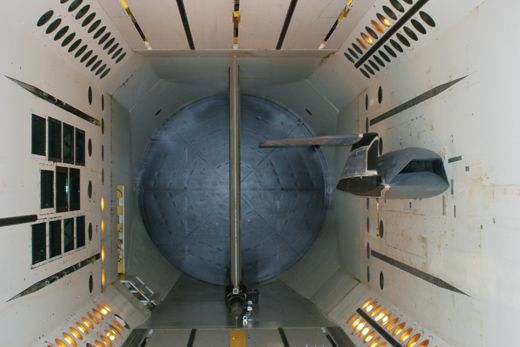Shape Shifters
Shape-memory polymers and other technologies may create an airplane for all missions.
/https://tf-cmsv2-smithsonianmag-media.s3.amazonaws.com/filer/Wing_Morph_631-mar07.jpg)
No aircraft excels in all conditions, which is a pity because if one did, it would rule the world. Commercial airliners, for example, which are designed to cruise at high altitudes over long distances, make lousy fighters. But the day is soon coming when one aircraft might do the job of two—or many more.
New “morphing” technology promises adroit aircraft that reshape themselves, bird-like, in flight. University and industry researchers funded by the Defense Advanced Research Projects Agency and others are experimenting with wings and helicopter rotors that fold, shrink, extend, tilt, and twist in flight. It’s a breakthrough in airplane design that would let a single airplane take on the persona of a bomber one moment, a fighter the next.
“Morphing lets one type of airplane do all types of missions,” says Rick Lind, an assistant professor of mechanical and aerospace engineering at the University of Florida. His team has built small remote airplanes that morph in a half-dozen different ways. One folds its wings—first into the shape of an M for steady, stable flight. Then it reverses them—in 15 seconds—into a W, making it so maneuverable it turns on a dime. The research is funded by the Air Force, which wants remote aircraft that can wheel through cities like hawks.
The trick to making it work is finding a way to muscle into entirely new shapes without losing control of the airplane. That’s not hard for Lind, whose airplanes are featherweight and flexible—nylon fabric over a carbon fiber frame. But for bigger aircraft it takes much more: wings limber enough to morph but tough enough to carry plenty of weight, a light but strong power system to reconfigure the wings in flight, and smart flight controls able to adjust to changing aerodynamic conditions.
Morphing wings have been around since the Wright brothers, who controlled their Flyer by twisting the wingtips. In 2005, the Air Force, NASA, and Boeing wrapped up tests on an F/A-18 Hornet that twisted its wings to roll at high speeds. But DARPA is after far more dramatic morphing, hoping to alter wingspan and wing area by at least 50 percent.
One promising approach is aimed initially at helicopters, not airplanes, and takes after one of nature’s creations: plants. Flowers angle their stems by shifting fluid from one cell to another. Lithium batteries also change shape as ions flow in and out of them when they are charged and discharged. You may not notice the batteries changing shape, but “your cell phone designer and your iPod designer know about it and design around it,” says Yet-Ming Chiang, a professor of materials science and engineering at the Massachusetts Institute of Technology.
Chiang and colleague Steven Hall took advantage of the shape-changing nature of batteries by building the same materials into a model of a Blackhawk helicopter blade. They found a small dose of energy could reshape the blade, altering the angle of its trailing edge to give it more lift. That’s great for hovering, but the blade doesn’t need as much lift in flight mode. A morphing blade could simply return to its original shape when it’s time for the helo to fly away.
The MIT team, now awaiting a DARPA decision on further funding, is still a long way from a full morphing helicopter. But the research shows shape-changing battery materials are lightweight, hold up under tremendous strain, and aren’t bothered by the frigid temperatures of high-altitude flight, Chiang says.
But if morphing is so great, why is it only taking off now? It hasn’t been much of an option before, since the stress of high-speed flying demands tough airframes with little flexibility in the air. So designers built different airplanes for different purposes: fuel-efficient, long-winged reconnaissance craft and high-speed fighters. The trouble is, the multi-aircraft approach can be cumbersome on today’s battlefields.
“If you’re a unit pinned down in Iraq, you don’t want to wait an hour” for help, says Terry Weisshaar, manager of DARPA’s morphing aircraft structures program.
That urgency is merging with advanced new materials into shape-shifting schemes that could outmaneuver rigid-winged foes. A Lockheed Martin design starts out with long wings with plenty of lift and maneuverability. Then the wings fold up. The inner half nests into the fuselage, leaving the outer half as a shorter wing better suited for high speed. So far it exists only as a wind tunnel model, but it’s loaded with new features. A polymer expands when heated by an electrical current, which reshapes the leading edge of the wing. The wing has a seamless skin, so when its joints move, gaps do not open up and create drag. One option is a “shape-memory” polymer that relaxes to allow movement and then stiffens back into shape.
Lockheed’s main competitor in morphing research, NextGen Aeronautics in Torrance, California, devised latticework wings with stretchable skin that sweep back, bat-like. NextGen is now designing an unmanned model that can not only morph in flight, but also shift shape to make sharper turns and steeper climbs.
If it’s a trick to morph an aircraft, imagine piloting the thing. Flight controls usually depend on predictable responses: Bank right, and the airplane turns right. But it may not if the wings are shifting shape at the same time. “If you shape-change too quickly, you destabilize the whole aircraft,” says Ephrahim Garcia, a Cornell University mechanical and aerospace engineer.
So engineers must devise smart flight control systems that adapt seamlessly to changes in the airplane during flight, something birds do instinctively. Lind and his students have studied seagulls and bats for flying tips. Their model maneuvers by twisting its wings. After all, a bird has no flaps or ailerons. It changes course by changing shape, and that’s the most effective morphing of all.
